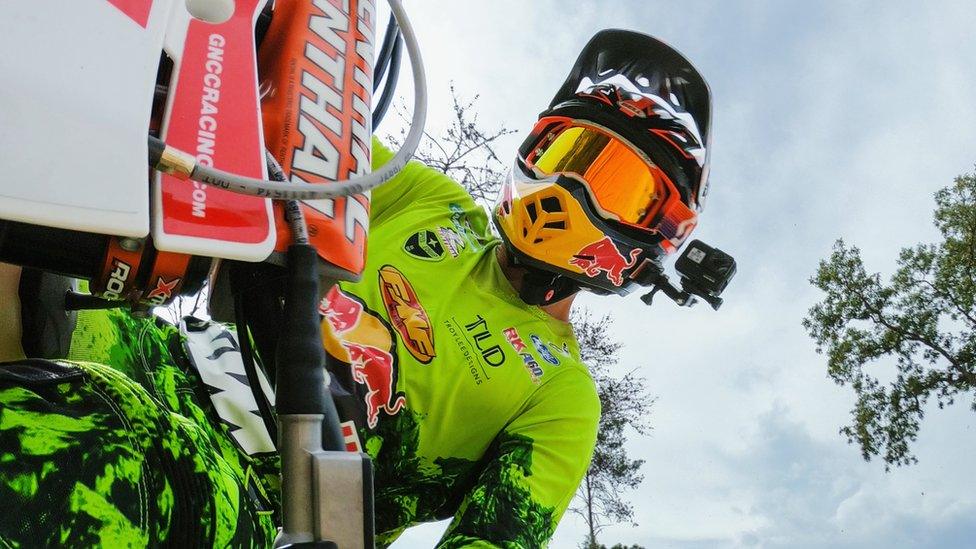GoPro Hero 7 camera films smooth videos without gimbal
- Published
WATCH: GoPro's new stabilisation put to the test
GoPro hopes it can tempt film-makers to try its latest camera with the promise of smooth videos without the need for stabilisation equipment.
Its Hero 7 Black records "Hypersmooth" steadied clips in real-time.
GoPro has posted a loss in all but one of its past 11 quarters, leading to speculation it might be taken over.
The company's founder told the BBC he hoped the latest camera line-up would help turn around its fortunes but did not rule out a sale.
"I have a responsibility as GoPro's [chief executive] to be looking for the best return in value creation for our investors and also to realise the best product experience for our customers," Nick Woodman said.
"And if there's a way to do that more effectively with a strategic partner, then of course that's something we are going to look at.
"But to be candid, my focus and our leadership team's focus is not on trying to sell the business.
"We don't have an active process going on. We're focused on restoring GoPro to growth and profitability."

The camera now detects when it is being used in vertical mode
Mr Woodman added that his company believed about half its active customers were using Hero 4 or older cameras, presenting it with a "huge opportunity".
But one company-watcher has doubts.
"As much as they have improved a lot of stuff in the new cameras, there's still a real question as to whether there's enough to convince existing GoPro owners to upgrade," said Cam Bunton, contributing editor at the gadget review site Pocket-lint.
"At £379.99 the Hero 7 Black is still not a casual purchase."
Anti-shake
This year's product line-up represents a back-to-basics approach, lacking a new category such as 2017's 360-degree Fusion camera, 2016's Karma drone or 2015's Session mini-cam.

The White and Silver models lack some of the Black's features including its Hypersmooth mode, and take 10 megapixel rather than 12MP photos
The White, Silver and Black models all look alike and feature a new touchscreen user interface meant to simplify their use.
There are no improvements to frame rates or resolution - the maximum setting is still 4K at 60 frames per second on the Black edition and lower on the other cameras.
Instead, the flagship feature for the top-end model is its new Hypersmooth facility, which Mr Woodman said had been GoPro customers' "number one feature request".
The effect is achieved digitally rather than by physically moving the camera sensor internally to compensate for shake. Software slightly crops the picture and then uses the extra leeway to compensate for shakes and bumps while warping parts of the footage if necessary.

The new GoPro Hero Black (right) features a new user interface
Although the previous generation of camera did something similar, GoPro says the results are far superior this time round.
It says they even exceed what was possible with its own Karma Grip gimbal, an accessory that used to effectively double the cost of a camera.
"It can be used underwater... Hypersmooth is wind resistant at any speed," said Mr Woodman.
"And it is capable of correcting for high frequency vibrations that would usually result in rolling shutter," he added, referring to a jello-motion-like effect caused by a camera sensor being moved as it scans a scene.

GoPro suggests the in-body stabilisation can produce better results than a gimbal in many circumstances
Users who record videos from cameras strapped on to helmets or the sides or vehicles should be among those that benefit.
However, in some situations the warping involved can make images look unnatural.
The effect cannot be removed in post-production, so some users may prefer to switch it off and use specialist software to stabilise footage in a more controlled manner.
Doing it in-camera, however, is quicker.
Moreover, the Hero 7 Black offers a Timewarp feature that marries the stabilising effect to time-lapses.
This allows the users to move about as they film, to create sped-up footage that does not look shaky.
The result is similar to a Hyperlapse , external- a process that usually requires a user to take hundreds of still images and then laboriously edit them together.
The company is also making it easier to livestream footage to Facebook and other social media platforms.
Mr Woodman said his company's use of its GP1 chip, which debuted last year, had helped make this possible.
"If we were still relying on open-market available processor and were developing cameras the way some of our competitors do, I don't think it would be possible to have made this breakthrough," he said.
Social streaming
Other improvements include:
a redesigned microphone membrane to reduce noise caused by vibrations that pass through the mount
a SuperPhoto mode, which automatically decides when to deploy noise reduction and high dynamic range (HDR) facilities
auto-detection of when the camera is turned on its side for vertical videos, to avoid the user having to rotate the images in the edit

The Hero Black 7 can livestream footage when paired to a smartphone
GoPro's own app can now livestream footage to Facebook without the need for additional third-party software.
This is limited to 720p resolution. It intends to add support for YouTube and Instagram later.
Squeezed out?
Mr Woodman said GoPro expected to sell about 16% more cameras this year than in 2017.
But with smartphones becoming more robust and mirrorless cameras offering a more travel-friendly alternative to digital single-lens reflex cameras (DSLRs), GoPro risks getting squeezed.

GoPro expects the Hero 7 Black will help it perform better than last year
"Smartphone cameras are getting really good stabilisation, really good slow-motion video and are now waterproof," said Mr Bunton.
"So, the actioncam market is niche and if that's the only thing you do, things could get tough."
- Published20 September 2018

- Published23 August 2018

- Published8 January 2018

- Published28 September 2017
